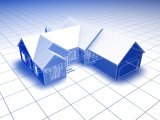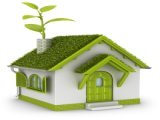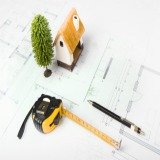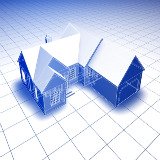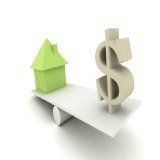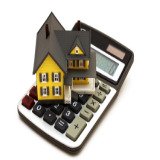The Cost To Build A Home, An Overview Of How Construction Cost Are Calculated
How exactly do I estimate the cost to build a home? You must be asking yourself this question if your reading this page. You will be shown the methods of cost estimating and how the cost to build a home is calculated!
Where does cost analysis begin and end? The answer to this question can vary greatly depending upon what you are planning to do with your home plans.
Cost Estimation
An appraiser estimates the cost to build (including direct cost, indirect cost, and an appropriate entrepreneurial incentive or profit) by using one of three traditional techniques:
- The comparative unit method
- The unit in place method
- The quantity survey method
The comparative unit method derives a cost estimate in terms of dollars per square unit of area or volume based on known cost of similar homes that are adjusted for time and physical differences. A written example of a unit of area or volume would be:
Homes in the mid-atlantic region of the country that are of average quality can be built for $50 dollars per sqaure foot.
Appraisers, insurance companies, major home builders, local jurisdictions, all get comparative unit cost information from cost manual services. Cost manual services publish data for estimating the cost to build a home (building materials). My favorite is:
Marshall and Swift Publication Company's Residential Cost Handbook
Look below for an example of a comparative unit report:
National building base cost per sq. ft. - $82.19
Locational adjustment from cost manual (your zip code - ex. 22312) - 1.14
$82.19 * 1.14 = $93.69 per square foot (Base Cost Subtotal)
House square footage - 4,500
$93.69 per sq.ft. * 4,500 sq.ft. = $421,626 (Total cost to build this home)
The unit in place method is a cost estimating method in which total building cost is estimated by adding together the unit cost for the various building components as installed. An example of this is below:
Unit In Place Cost Report - (only direct cost included)
Property: Johnson Residence
Property Owner: Chris Johnson
Address: 7428 Builder Street
City: Alexandria
State/Province: VA
ZIP/Postal Code: 22312
Single-family Residence
Floor Area: 4500
Effective Age: 0
Quality: 5.5 Very Good/Excellent
Cost As Of: 06/21/2009 (current date)
Condition: Good/Very Good
Style: Two Story
Exterior Wall: Brick Veneer 100%
Plumbing Fixtures: 14
Units * Baes Cost = Total
| Component Type | Units | Base Cost | Total |
|---|---|---|---|
| Base Cost | 4,500 sq. ft. | $70.39 | $316,755 |
| Plumbing Fixtures | 14 | $2,160 | $30,240 |
| Clay Tile | 4500 sq. ft. | $6.71 | $30,195 |
| Raised Subfloor | 100 | $10.87 | $1,087 |
| Floor Insulation | 4500 sq. ft. | $0.83 | $3,735 |
| Carpet and Pad | 75 | $6.94 | $520 |
| Ceramic Tile | 25 | $17.05 | $426 |
| Warmed & Cooled Air | 4500 sq. ft. | $4.91 | $22,095 |
| Plumbing Rough-ins | 1 | $561.91 | $562 |
| Single 2-story Fireplace | 1 | $7,522 | $7,522 |
| Appliance Allowance | 1 | $8,489 | $8,489 |
| Structure Total Cost | $421,626 |
| Component Type | Unit | Base Cost | Total |
|---|---|---|---|
| Attached Garage | 700 sq. ft. | $36.53 | $25,571 |
| Garage Subtotal | $25,571 | ||
| Land | $125,000 | ||
| Improvement Total (Structure + Garage) | $447,200 | ||
| Total (Improvement total + Land) | $572,200 |
The quantity survey method is the cost estimating method in which all materials (unit cost) and labor requied are estimated to arrive at a total project cost esitmate.
This method is used by contractor's (home builders) to breakdown how much it will cost to build your home. This report usually looks the same as the unit in place method report but labor is included in the quantity survey method report.
There are two different types of cost to build a home. The first is:
Reproduction cost: The estimated cost to construct an exact replica of an improvement (house), using the same cost, materials, and design as when the home was orginally built.
This type of cost is used when a property needs to be built the same way it used to exist.
You will not be using this type of cost to crunch your numbers. The reason is simple, you are building a new home, not replacing an existing house.
The second type of cost is:
Replacement cost: The estimated cost to construct a new building using modern materials, standards, design, and layout. Replacement cost are what's listed in the cost manuals desribed above. You will use replacement cost to build your home and to help figure out your home building price range!
The first component of construction cost is:
Direct (hard) cost: Expenditures for labor and materials used for construction of building improvements. The items that can be included in direct cost are:
- Labor - salaries and wages of your construction workers (unless your an owner builder)
- Materials - Items used to construct your property (wood, concrete, nails, etc.)
- Subcontractors - plumbers, electricians, etc.
- Heavy equipment - used by your contractors
- Construction Oversight - your general contractor and their profit margins (usually no less than 10% of your overall project cost)
- Utility charges
- Temporary toilet facilities (i know.....yikes.....but necessary)
The list could go on and on. The second component of construction cost is:
Indirect (soft) cost: Expenditures of items other than materials and labor that are necessary for construction but are not typically part of the construction contract. These indirect items can be:
- Architectural and engineering fees
- Appraisal, consulting, accounting, and legal fees
- Mortgage payments during construction
- County or jurisdicational taxes during construction
- Administrative expenses of builder
The last component of construction cost is:
entrepreneurial incentive (profit!): A market dervied figure that represents the amount you expect to receive for the contribution of building your home. I know your thinking, this is my dream home and that's my incentive.
The cost to build a home can be summed up by stating that you will have help along the way with determining cost from the professionals (General contractor, Appraiser, Mortgage broker, etc.) you hire to help build your property. You will not be alone!
You Might Also Like:
Home Design Floor PlansHome Design Floor Plans |
Green Home DesignsGreen Home Design |
Boat Home PlansBoat Houses |
